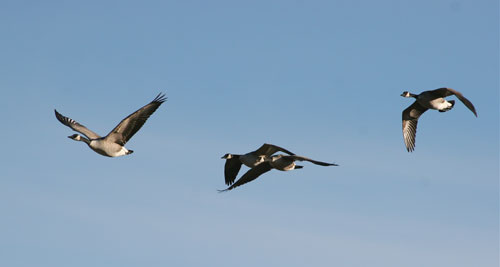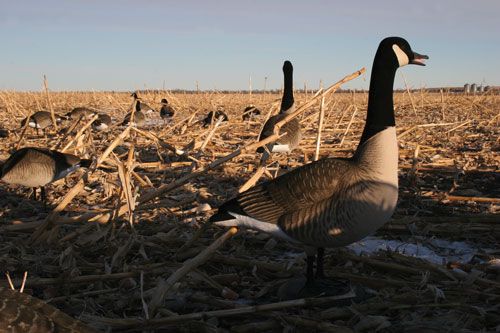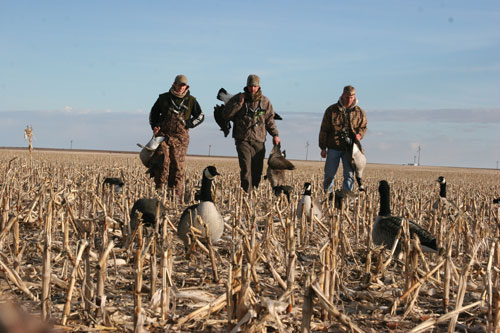 I’ve hunted geese for nearly a half-century in more places than I can remember. But never have I seen a spot so infested with Canada geese as Pierre, S.D. Located near massive Lake Oahe on the sprawling Missouri River, Pierre is smack dab in the middle of the Mount Rushmore State and at the heart of North America’s central flyway.
I’ve hunted geese for nearly a half-century in more places than I can remember. But never have I seen a spot so infested with Canada geese as Pierre, S.D. Located near massive Lake Oahe on the sprawling Missouri River, Pierre is smack dab in the middle of the Mount Rushmore State and at the heart of North America’s central flyway.
With a population of only about 15,000, Pierre is the second least-populated state capital in America (Montpelier, Vt., is the first), but it’s one of the most populous for waterfowl. Fall through spring, geese outnumber people in the Pierre area by at least eight to one. And at times, geese and ducks outnumber people 30 to one.
That’s a lot of webbed feet. So many, in fact, that while standing beside the state capital, it’s commonplace to watch hundreds of geese wing overhead. They fly by almost constantly, honking and clucking in singles and doubles, tight clutches, and at times, in wedges and Vs by the hundreds.
There are geese in the parks, geese in the parking lots, geese in backyards and on front lawns, in streets, crossing busy roads, adjacent to office complexes, in shopping areas and in every lake, pond, river and stream — frozen or not.
Geese are as much a part of Pierre life as pigeons and sparrows, or cold wind and snow. Deer-crossing signs should be replaced by goose-crossing signs; residents don’t worry as much about low-flying aircraft as they do about low-flying honkers.
There are so many geese, in so many Pierre places, that kids frolic with them in parks as they would with squirrels or rabbits. Geese are more common in Pierre than cats and dogs, cars and bikes. Most wild honkers are born and raised 2,000 miles away in their native Arctic Circle habitat. But when they vacation in Pierre, they are so tame that local citizens feed them by hand.
With so many geese, so few people and massive corn and wheat farms spanning many thousands of acres in all directions, it comes as no surprise that Canada goose hunting in the Pierre area is among the best in the world. Access is good and gunning is extraordinary. And the season runs long, from October well into February in Hughes County, home of Pierre.
A Typical Hunt
Pierre native and lifelong waterfowler Tyson Keller showed me the local goose-hunting ropes for a couple of days last winter. Late one afternoon Tyson picked me up at the Pierre airport (small, but not busy), and he suggested we head out into the wheat, corn and green-stubble fields near the South Dakota state capital.
“We’ve got lots of hunting sites available to us, but we need to locate a field or two where birds are coming in before choosing one to hunt tomorrow morning,” he said as we headed out of town.
There were no freeways or toll booths to navigate, just a friendly few streets through Pierre. In minutes we were skirting Lake Oahe, which is something of a modern water miracle, as it extends for over 200 miles along a dammed portion of the Missouri River. Then we drove onto a prairie-land plateau above the reservoir, where wheat- and cornfields spread seemingly forever.
“Big open water along the Missouri River is what brings ducks and geese here from Canada,” Tyson told me as he drove. The sun was setting lower by the minute. “But grain fields are what keep them here in hunting season, because without food, they’d fly south.”
As the sun skimmed the western horizon, geese were seen on the move. Thousands and thousands of birds headed off the water, winging toward farms and fields to feed. Tyson knew the rural highways and farm-field roads from a lifetime of driving and hunting. He’d spot several big wedges of geese winging in one direction, and in minutes we’d be in hot pursuit, watching where they were headed.
Over the next hour we located several spots where geese circled and dropped down to feed. Using a binocular, he’d check a field, note the wind direction and mentally record how and where to reach the best spots in the pre-dawn dark the following morning.
“No ducks around. Shouldn’t there be mallards?” I asked.
“There are over 100,000 mallards on Lake Oahe right now,” Tyson replied, smiling. “But it’s the strangest thing; they’re nocturnal, so there’s almost no field-hunting for ducks. Mallards leave the lake at dark to feed and go back to open water to roost before dawn. Sometimes good duck shooting is available from boat blinds. But it’s difficult and there’s a lot of work involved.
“I prefer hunting mallards an hour or so from Pierre, where there are plenty of ducks, and they aren’t nocturnal. Near Pierre, the Canada goose is king.”
 At sunset Tyson parked his truck on a towering butte, and with a binocular he showed me huge flocks of mallards heading off the lake toward fields for feeding. Never in two days of goose hunting did I see ducks flying, nor working into fields for feeding. They were, as Tyson said, nocturnal; strange, but true. Canada geese were a different story.
At sunset Tyson parked his truck on a towering butte, and with a binocular he showed me huge flocks of mallards heading off the lake toward fields for feeding. Never in two days of goose hunting did I see ducks flying, nor working into fields for feeding. They were, as Tyson said, nocturnal; strange, but true. Canada geese were a different story.
The following morning Tyson and a pair of his pals — Rapid City’s Foster Barthalow (a national trap-shooting champion) and Austin Rounds of Pierre — picked me up before daybreak at a local motel. Thirty minutes later we lumbered across a snow-glazed cornfield in Tyson’s oversize pickup truck, with an enclosed trailer full of field blinds and 400 “flocked” decoys.
Tyson picked a slight rise in the field, and after studying the wind, we set out decoys, then parked the truck well out of the field as the sun was rising. Shortly after daybreak, Canada geese filled the sky. Little clusters, wedges and family groups were everywhere, sailing above the horizon.
“This is gonna be a hunt to remember,” Tyson said as he sat next to me inside a portable field blind watching the spectacle of waterfowl slowly envelop us.
“Yep. I believe we’re in the right spot, on the right day, and have the right blind and decoy setup,” said Foster.
“Let’s close our blinds and get down,” said Tyson as he spied a good wedge of low geese working their way to us from distant Lake Oahe.
Tyson, Foster and Austin started calling, and the incoming geese replied and dropped lower. Soon the birds broke out of their large V into small clusters and groups, preparing to land. They circled and rolled over on their sides, falling through the frigid South Dakota sky like oversize leaves. A couple of small flocks landed as we waited for a large group of greater Canadas to set up just over the decoys.
 Finally, with 40 birds spread out downwind at 25 yards, wings locked and legs hanging, Tyson called the shot. With shotguns swinging, we burst out of the blinds, and the sky was full of squawking and backpedaling geese; then guns barking, birds falling, others rolling out in flight and leaving.
Finally, with 40 birds spread out downwind at 25 yards, wings locked and legs hanging, Tyson called the shot. With shotguns swinging, we burst out of the blinds, and the sky was full of squawking and backpedaling geese; then guns barking, birds falling, others rolling out in flight and leaving.
We took a quick count of downed geese, and we still needed four to collect our three-birds-apiece limits. Before I could reload, more geese were swinging downwind, and within a few minutes we tagged out on the big honkers.
“You plan and work so hard for a hunt, and then it’s over in just a few minutes when it’s just right,” Tyson said as he held up a couple of the greater Canadas.
After the birds were counted and collected, we sat there watching waterfowl fill the sky, until Tyson suggested we get back in the blinds and just watch more birds drop into our spread. And that’s what we did.
It was incredible. Lying there, I found myself smiling, and then laughing in an awestruck way, giddy as a kid opening birthday presents. It was a morning every wingshooter who admires waterfowl would envy. And we still had another dawn of goose hunting to look forward to.






